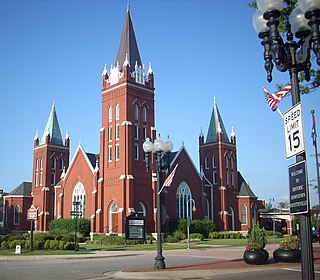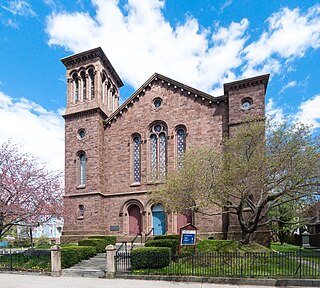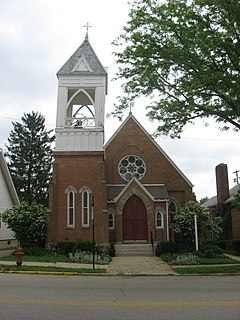York Street Historic District | |
York Street Cafe | |
| Location | Newport, Kentucky |
|---|---|
| Coordinates | 39°5′15″N84°29′34″W / 39.08750°N 84.49278°W Coordinates: 39°5′15″N84°29′34″W / 39.08750°N 84.49278°W |
| Built | 1848 |
| Architect | Unknown |
| Architectural style | Greek Revival, Late Victorian, Late 19th And 20th Century Revivals |
| NRHP reference # | [1] |
| Added to NRHP | May 26, 1995 |
The York Street Historic District in Newport, Kentucky was listed on the National Register of Historic Places on May 26, 1995. Most of the buildings were built in the mid and late Victorian era. The district is bounded by Seventh Street on the north and Tenth Street on the south.

Newport is a home rule-class city at the confluence of the Ohio and Licking rivers in Campbell County, Kentucky, in the United States. The population was 15,273 at the 2010 census. Historically, it was one of four county seats of Campbell County. Newport is part of the Cincinnati Metropolitan Area, which includes over 2 million inhabitants.

The National Register of Historic Places (NRHP) is the United States federal government's official list of districts, sites, buildings, structures, and objects deemed worthy of preservation for their historical significance. A property listed in the National Register, or located within a National Register Historic District, may qualify for tax incentives derived from the total value of expenses incurred preserving the property.

In the history of the United Kingdom, the Victorian era was the period of Queen Victoria's reign, from 20 June 1837 until her death on 22 January 1901. The era followed the Georgian period and preceded the Edwardian period, and its later half overlaps with the first part of the Belle Époque era of Continental Europe. In terms of moral sensibilities and political reforms, this period began with the passage of the Reform Act 1832. There was a strong religious drive for higher moral standards led by the nonconformist churches, such as the Methodist, and the Evangelical wing of the established Church of England. Britain's relations with the other Great Powers were driven by the colonial antagonism of the Great Game with Russia, climaxing during the Crimean War; a Pax Britannica of international free trade was maintained by the country's naval and industrial supremacy. Britain embarked on global imperial expansion, particularly in Asia and Africa, which made the British Empire the largest empire in history. National self-confidence peaked.
The York Street Historic District, while smaller than East Row Historic District, contains a variety of interesting buildings and businesses, including some beautiful churches.

East Row Historic District is the second largest Historic District in the Commonwealth of Kentucky. It is located in Newport, Kentucky. The East Row was created by joining two of Newport's Historic Neighborhoods; Mansion Hill and Gateway.
The Salem United Methodist Church (now The Stained Glass Theatre), is at Eight and York. It was built in 1882 and designed by Samuel Hannaford. In 1986 Newport's Salem United Methodist Church was placed on the National Register of Historic Places. On March 10 it was damaged by a tornado. Damage estimates at the time were $210,000. The church congregation capped the steeple, repaired the holes and removed the debris, but due to a decrease in membership and a great deal left to repair, they felt it would be best to merge with another Methodist congregation, and put the church up for sale.
Samuel Hannaford was an American architect based in Cincinnati, Ohio. Some of the best known landmarks in the city, such as Music Hall and City Hall, were of his design. The bulk of Hannaford's work was done locally, over 300 buildings, but his residential designs appear through New England to the Midwest and the South.
Other churches in the district include the First Baptist Church at 8th and York Streets and the former York Street Congregational Church.
The York Street International Café (Eighth and York streets) displays the original stained glass sign from its historic use as a drugstore. [2]

Pharmacy is the science and technique of preparing, dispensing, and review of drugs and providing additional clinical services. It is a health profession that links health sciences with pharmaceutical sciences and aims to ensure the safe, effective, and affordable use of drugs. The professional practice is becoming more clinically oriented as most of the drugs are now manufactured by pharmaceutical industries. Based on the setting, the pharmacy is classified as a community or institutional pharmacy. Providing direct patient care in the community of institutional pharmacies are considered clinical pharmacy.






















